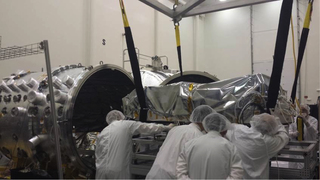
Issue 16 - April 2016
By Ilya Poberezhskiy and Hong Tang
This February, for the first time, the dynamic Occulting Mask Coronagraph (OMC) testbed was placed into HCIT-1 vacuum tank to commence the work on the last, and most challenging, WFIRST system-level coronagraph milestone #9. This advanced testbed has many new features for more realistic testing of space coronagraphs:
- Masks and stops for two coronagraph modes (Shaped Pupil and Hybrid Lyot) on the same testbed – similar to WFIRST flight coronagraph instrument – with mechanisms to remotely switch between these two modes,
- A scaled mini-WFIRST telescope simulator with a representative obscured pupil that can produce expected on-orbit disturbances such as telescope pointing errors and thermal drifts,
- A low-order wavefront sensor that uses the rejected “star” light and is capable of both sensing angstrom-level wavefront errors and controlling a fast-steering mirror, focus adjustment, and a deformable mirror to reduce these disturbances,
- Highly stable and extensively modeled optical mounts to enable the validation of coronagraph bench structural, thermal, optical, performance (STOP) models. Improvements were also made to the vacuum chamber’s mechanical isolation, thermal insulation, and stray light control.
The WFIRST coronagraph team and the HCIT facility team have worked for over a year to design, model, build, test and integrate all the components and subsystems that went into this new high-fidelity testbed. Now the hard work of demonstrating that WFIRST coronagraph works in a simulated on-orbit environment really begins!
- WFIRST is a NASA project managed by the Goddard Space Flight Center
- WFIRST coronagraph instrument is managed by the Jet Propulsion Laboratory
- HCIT is a NASA facility funded by the Exoplanet Program Office
Ilya Poberezhskiy, WFIRST Coronagraph Testbed Manager
Hong Tang, High Contrast Imaging Testbed (HCIT) Facility Manager, Jet Propulsion Laboratory
